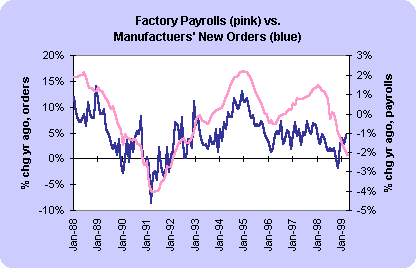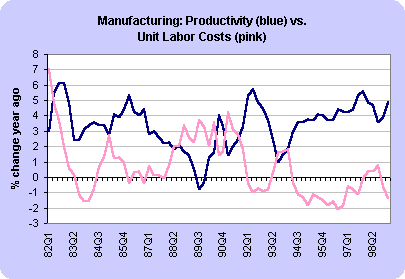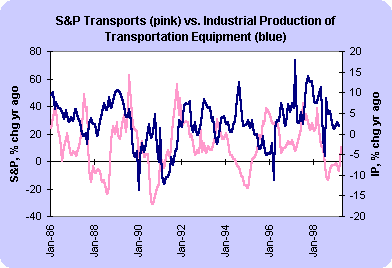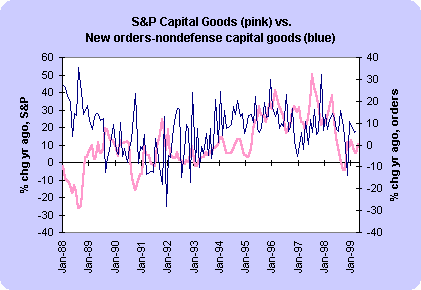Using Orders & Production Indicators to Signal Stock Prices
Evelina M. Tainer, Chief Economist

...but maybe not so soon...
The improvement in manufacturers' orders might not immediately translate into employment growth. The following chart depicts productivity and unit labor costs in manufacturing. Note that the rapid gains in productivity are accompanied by declines in unit labor costs. This bodes well for manufacturers' profits. It hinders inflationary pressures since productivity gains allow producers to increase employees' wages, but not consumer prices. Without inflationary pressures, stock price valuations ultimately benefit. If product prices aren't raised, producers will sell more goods. At the same time, a lack of inflationary pressures sets the stage for a low interest rate environment. Lower interest rates reduce business borrowing costs and increase company valuations. Low inflation also prevents the Federal Reserve from tightening credit conditions and raising interest rates.

S & P 400 Industrials
The chart below depicts the yearly change in the Fed's index of industrial production compared with the S&P 400 Industrials index. Admittedly, the correlation is not as strong as one would expect. The S&P industrials index shows a somewhat less cyclical nature than the index of industrial production. It is a long-established fact that stock prices lead the economy. The industrials stock price index appears to lead the industrial production index by as much as two years. The strength in this index in the past year would point to an acceleration in production in coming months.

Planes, Trains & Automobiles
The transportation industry is very volatile. The auto industry has strong cyclical variation, but tends to be more stable over a short run period. On a month-to-month basis, aircraft production is more stable than new orders, but the sector shows a lot of month-to-month variability nevertheless. While stock prices in the transport industry were sluggish in the second half of 1998 and early 1999, prices increased in April. Production of transportation equipment stabilized in early 1999. If production revives more decidedly in the next couple of months, investors might find additional signs of life in stock prices. Yet, given the differences between aircraft and motor vehicles, investors would benefit by looking at the components separately. If you are interested in Ford or GM stock, look at auto & truck sales and production. If Boeing caught your eye as a potential stock acquisition, check out orders, shipments and production of aircraft.

Basic Materials
Stock prices of basic materials were headed lower throughout 1998 and early 1999. The stock price index for basic materials seemed to mimic the movement of new orders for basic materials industries, which include stone, clay & glass, primary metals and fabricated metals. New orders have recently turned around while stock prices are still headed lower. If orders were to rise more dramatically in coming months, a rebound in stock prices may ensue.

Capital Goods Industries
Manufacturers' new orders are generally volatile. Similarly, new orders for nondefense capital goods also fluctuate wildly because of aircraft. The chart below depicts yearly changes in nondefense capital goods in comparison to yearly changes in the stock price index of capital goods. The correlation between the two series is pretty good. It does appear that consistent gains in new orders for nondefense capital goods could lead to higher stock prices for this industry in the near term. Capital spending expanded more rapidly than corporate cash flow for the past two years. A revival in corporate profits could keep the capital expenditure machine grinding.

THE BOTTOM LINE FOR INVESTORS
The moderation in manufacturing activity did play a role in the slower rate of stock price appreciation in various industries. In comparison with the consumer -related stock price indices, the manufacturing sector indices were much more sluggish.
It is useful for investors to follow manufacturing indicators in a more detailed fashion as shifts in demand over time will likely lead to shifts in those companies and industries gaining the highest profits. For instance, if you are interested in companies such as Boeing or B.F. Goodrich, follow trends in aircraft new orders, shipments and production. If companies in the chemical industry such as DuPont and Praxair have caught your eye, make sure to look at new orders, shipments and production of chemicals in the manufacturers' report and a subcategory in the index of industrial production. Emerson Electric and Rockwell International are electrical and electronic companies; this detailed sub-category is available for new orders, shipments and production.
Overall economic conditions do help to assess the direction of stock prices. Yet, after the early phase of economic recovery, shifts in industry conditions suggests that sectors fall in and out of favor with investors. As a result, long-term investors as well as short-term speculators need to stay abreast of the various economic sectors where the potential profits are highest.